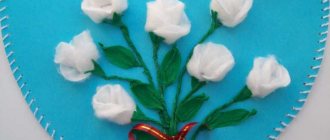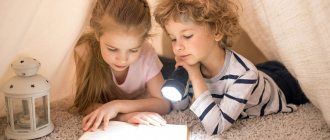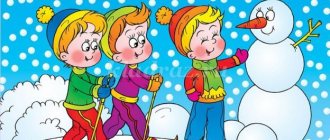Summary of a lesson on manual labor in the senior group on the topic “Kittens.”
One two three four five!
Come visit us guys
Look and count.
(S. Mikhalkov).
- Look how happy she is. After all, little kittens feel warm and comfortable next to their mother cat.
Sad music is playing.
- Guys, it seemed to me that someone meowed pitifully on your tables. Turn over your sheets of paper and see who it is? (Cat Mom).
- Why do you think your cats are sad? (Their little kittens are lost, they are not with their mother cat).
- Let's help cat mothers find their little kittens and construct little kitten faces out of paper.
- Look how I do it. (Showing methods of action).
— We will construct the kittens’ faces from a square. You have squares of different colors on your trays, so you will get kittens of different colors: one is white, the other is brown...
- Look how I make the face of a ginger kitten.
— I’ll bend the square in half with a “scarf.”
— I will bend the resulting triangle in half. I'll unfold it.
This is how we marked the middle of the triangle.
— I raise the corners from the middle of the long side, but do not bring them to the top of the upper corner. These are our ears.
— I raise the bottom corner a little up.
— I’ll bend the side corners a little bit towards the center line. Turn the workpiece over. I'll lower the top corner a little.
— It turned out to be the face of a kitten.
— If you bend the upper corner in the other direction, the muzzle will turn out a little different. Here it is. Anyone who wants to do it this way will also be fine. Using felt-tip pens I draw in the eyes, nose, mouth and mustache and my kitten becomes as if alive. To make the work neat, I will smear the cat’s face with glue on the back side, put a little glue on the brush, and remove the excess glue on the edges of the jar. I glue my kitten to my mother cat. I remove excess glue with a cloth. Look, he is also hidden in her fluffy fur, so that only one head is visible. And I'll call him Shustrik.
Consolidation.
- What will you do? (kitten faces).
—Where will you start working? (let's bend the square into a scarf).
— How do we mark the middle of the triangle? (let's bend it in half).
- What then? (Raise the corners, from the middle of the long side without bringing them to the top of the upper corner).
-Where should we bend the side corners? (slightly towards the midline).
- What then? (Turn the craft over and lower the top corner).
- How else can you bend the top corner? (Without turning the craft over, immediately the corner is down).
- Where can we put glue on the face? How?
-Where should we stick it?
— What needs to be done to make the kitten “come to life”? (complete the nose, eyes, mouth, mustache).
— When the work is ready, think about the name of your kittens, what kind of character they are.
Lesson notes for the senior group of preschool educational institutions. Manual labor
Summary of the organization of labor activity (manual labor) in the senior group
Title of work : Summary of labor activity (manual labor) in the senior group in accordance with the Federal State Educational area : Social and communicative development. Program development : Involve children in design creativity, through which decorations for the walking area and birthday gifts for peers will be made. Develop skills in working with cardboard and colored paper when making birds and in weaving bracelets and jump ropes from rubber bands. Improve skills in gluing cardboard onto a sheet of colored paper, folding paper diagonally like an accordion, weaving on a machine and slingshot in different ways. Develop image perception, color perception when choosing the color of rubber bands when combining them, paper when combining the color of a bird and wings; recreating and creative imagination, hand motor skills. Foster love for kindergarten by creating decorations for it; peers of the group, creating gifts for them. Friendly relations when performing work, the ability to work in a team, to help comrades. Equipment: Cardboard bird shapes, colored paper, paste, oilcloth, brushes, paste, scissors, twine; sets with elastic bands, hooks and weaving machines. Preliminary work : Examination of decorations for kindergarten areas, cutting out birds along the contour, learning to weave from rubber bands. Vocabulary activation: Weaving, hook, loop, loom, cardboard decoration, designers. Motivation: 1. Contribute the painting “Waiting for the Birds” Conversation about the content of the painting and what awaits us in the near future. Children answer the teacher’s questions, note what needs to be done in order to attract birds to their site, and how to please their peers on the day birth.
2. I propose to consider the material from which children’s crafts will be made. 3. I invite the children to divide into subgroups and choose a senior assistant in each subgroup. The children are divided into subgroups and choose a senior assistant. Subgroup 1, in collaboration with the teacher, makes birds to decorate the area. Subgroup 2 independently weaves bracelets from rubber bands. Main part:
The teacher gives instructions for the practical activities of children and directs the work of children in subgroups: 1 demonstrates folding paper with an “Accordion” and methods of weaving with rubber bands.
2 helps with difficulties and gives verbal and practical instructions when children perform work. After listening to the task and discussing how to complete it with the teacher, the children begin to complete the work; if necessary, they turn to the teacher for help. Senior assistants in subgroups help peers when necessary. Subgroup 2 independently chooses the type of weaving and works in collaboration with peers. The teacher's leadership of this subgroup is indirect. Health-saving technologies: 1. I suggest performing the finger game “Friendship” before completing work and after completing work. 2. Gymnastics for the eyes after completing work 3. Offer to perform dance movements to music. Reflection: Reviewing the work, noting why and for whom it was done
The area was decorated with these birds, and now they will greet feathered guests. And the bracelets were presented to the guests who attended this event.
We recommend watching:
Summary of educational activities in the senior group “Journey to a Fairy Tale” Summary of a mathematics lesson for children of the senior orthopedic group Summary of educational and gaming activities in the senior group in the section of the “Childhood” program Synopsis of educational activities for the perception of music in the senior group of kindergarten
Similar articles:
Lesson in the senior group of kindergarten on the topic of February 23
Lesson notes for children of senior preschool age. Topic: Invisible air
Summary of organized educational activities for children of the senior group
Notes for mathematics classes in the senior group
Lesson summary on the topic “Reserve” in the senior group
Notes outside manual labor classes in kindergarten
Working with children outside of manual labor classes on the topic “Composition in a circle”
Purpose: To give an idea of the technique of performing a composition in a circle using plasticine and seeds. Objectives: 1. Develop the ability to make crafts from natural and waste materials in a circle; develop imaginative thinking; fine motor skills of hands; 2. Activate and enrich vocabulary; 3. Cultivate a caring attitude towards nature, perseverance, and accuracy. Materials: Plastic lids (for mayonnaise, ice cream, etc.), watermelon seeds, melon seeds, plasticine. The teacher seats the children around him on the carpet in a circle. Educator: Guys, look at the picture. What is this? Children: Forest. Educator: Correct. Forest is the wealth of nature. There is nothing useless in the forest and nothing is wasted. Birds make nests from dry grass, twigs, leaves, and needles, ants build anthills, and animals line burrows with them. And how can you call in one word everything that you and I can find in the forest, everything that nature gives us? Children: Natural material. Educator: What can be made from natural materials? Children: Lots of different crafts. Educator: Besides natural materials, what else can you use to make crafts? Children: Paper, cardboard, buttons, beads... Educator: That's right! This is junk material. What is the difference between waste material and natural material? Children: Natural material is what nature gives us, and waste material is waste from human labor. Educator: Guys, I have a box, and in it there are seeds, which you will find out by guessing the riddles. Although he is striped, he still does not have a mustache. Although it has its own tail, it is short and dry. His sides are round, like a bun. And since his great-grandfather’s times, He is everyone’s favorite and sweet-loving. Who is this little guy? How do you think? Children: Watermelon. Educator: Correct! What are the seeds of a watermelon called? Children: Watermelon seeds. Educator: Well done! Next riddle. Round and yellow, like the bright sun. The most delicious, juicy and bright. Children: Melon. Educator: What are the melon seeds called? Children: Melon seeds. Educator: That's right - these are melon seeds. I also have these lids and plasticine in my box. What do we need them for? Children: For crafts. Educator: Are the lids a natural material or a waste material? Children: Brosovy. Educator: And the seeds? Children: Natural. Educator: Okay! And now I want to invite you to the tables where you can show what miracles you can make from natural and waste materials. We will try to make a composition in a circle - this is an original craft from plastic lids for mayonnaise or ice cream in buckets. This work can serve as both a decorative stand and a wall decoration.
But first, let’s stretch the plasticine and our hands. Physical exercise with plasticine Explain how it turns out: Why does everyone always turn into a neat set of plasticine, into whom is the terrible gray-brown-crimson? Educator: Take the lids and spread the plasticine inside the plate with a thin layer, you can take several colors.
We lay out a pattern of seeds on the surface of the plasticine in a circle.
Place a flower in the center of the circle.
Take your work and show how wonderful it turned out.
You really know how to create miracles! Well done!
We recommend watching:
DIY crafts for children made from natural materials. Ant Terra - do-it-yourself collage Floristry for preschool children Do-it-yourself application from plant seeds for children over 6 years old. Vase with Flowers
Similar articles:
Crafts made from natural materials in elementary school. Flowers from seeds
DIY autumn crafts for kindergarten. Master classes with photos
Summary of work activities for children of the senior group Type of labor: Manual labor
Summary of work activities for children of the senior group
Type of labor: Manual labor
Form of organization: Collective
Target:
create conditions for children's creative activity
Tasks:
Educational: To consolidate knowledge and skills when working with paper and scissors. Strengthen the ability to trace according to a template.
Educational: develop imagination and creativity.
Educational: cultivate sympathy for game characters, patience, perseverance, accuracy.
Methods and techniques:
surprise moment, fairy tale, demonstration of a method of action, question and answer, encouragement.
Equipment:
scissors, rectangular paper pieces, templates with figures of men, colored pencils or felt-tip pens.
Progress:
Motivation:
The teacher shows the children a paper man with a sad face (on the other side with a cheerful face).
Educator:
Look who came to us. Some little man. Look - is he happy or sad?
Children:
Sad.
Educator:
Sad little man, where are you from?
— I live in a fabulous paper country. This is a country of very kind people. We lived together, helped each other, had fun together. But then one day trouble happened. An evil wizard has appeared in our fairy-tale land. He saw beautiful paper houses, paper gardens, paper flowers. Do you think he liked it? No, because he is evil. He crushed and tore all the flowers and trees, and turned the funny little people into empty pieces of paper. I was the only one who survived because I managed to hide. When the evil wizard left, I collected all the pieces of paper, that's all that was left of my cheerful friends. I went to look for the good wizard. I was told that there are many good wizards in your garden. And I came to ask you for help. Oh, good wizards, please turn my enchanted friends back into cheerful, kind people.
Activity planning:
Educator:
Guys, what do you think - can we help the sad little man? We have everything you need for this. To do the magic right, let's consider our guest. That he has?
Children:
head, torso, arms, legs
Educator
: How can you make a man out of paper?
Children:
Draw and cut.
Educator:
That's right, but we won't just draw a little man, we'll trace it according to a template, cut it out, color it and make a garland of friendly and cheerful little people.
Implementation of the plan:
Children receive blanks of paper folded in three layers like an accordion and templates of people (girls and boys) and get to work. The teacher quietly turns the little man over to the other side with a cheerful face. Draws children's attention to the fact that the little man is cheerful because you children, good wizards, have turned pieces of paper into his friends. With the help of a little man, the teacher tells the children how to draw clothes and jewelry.




